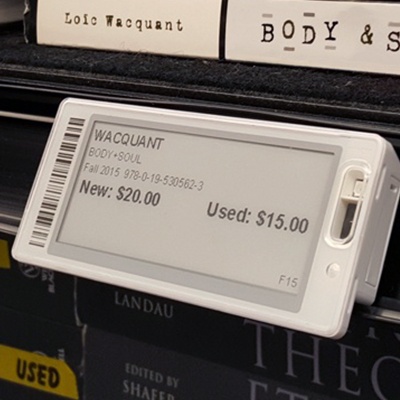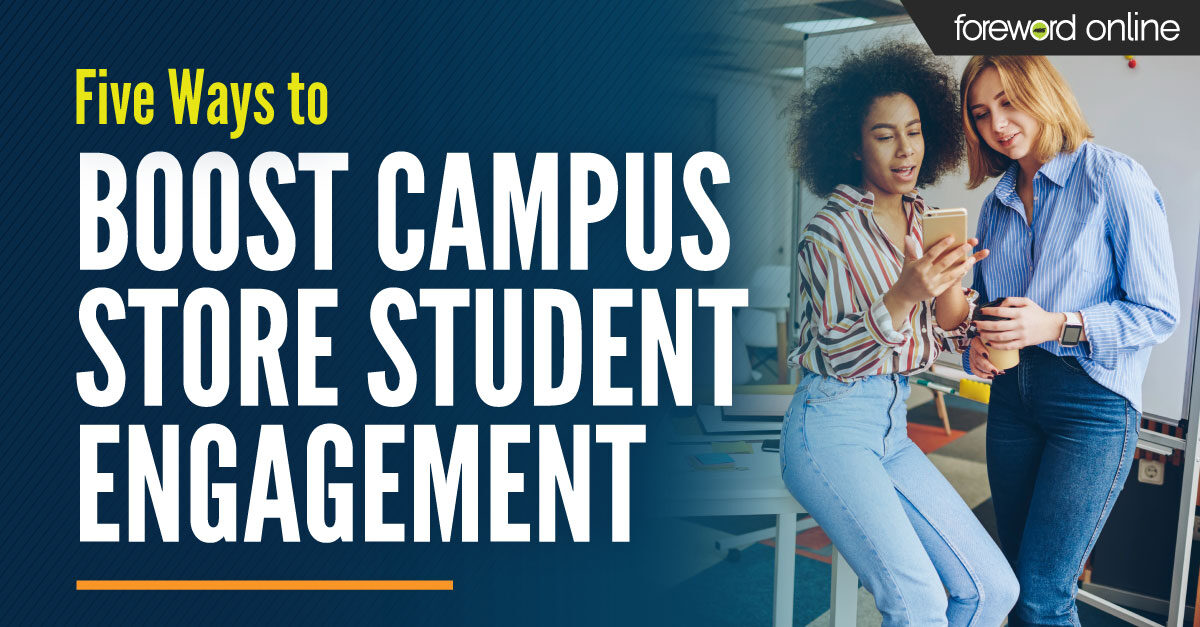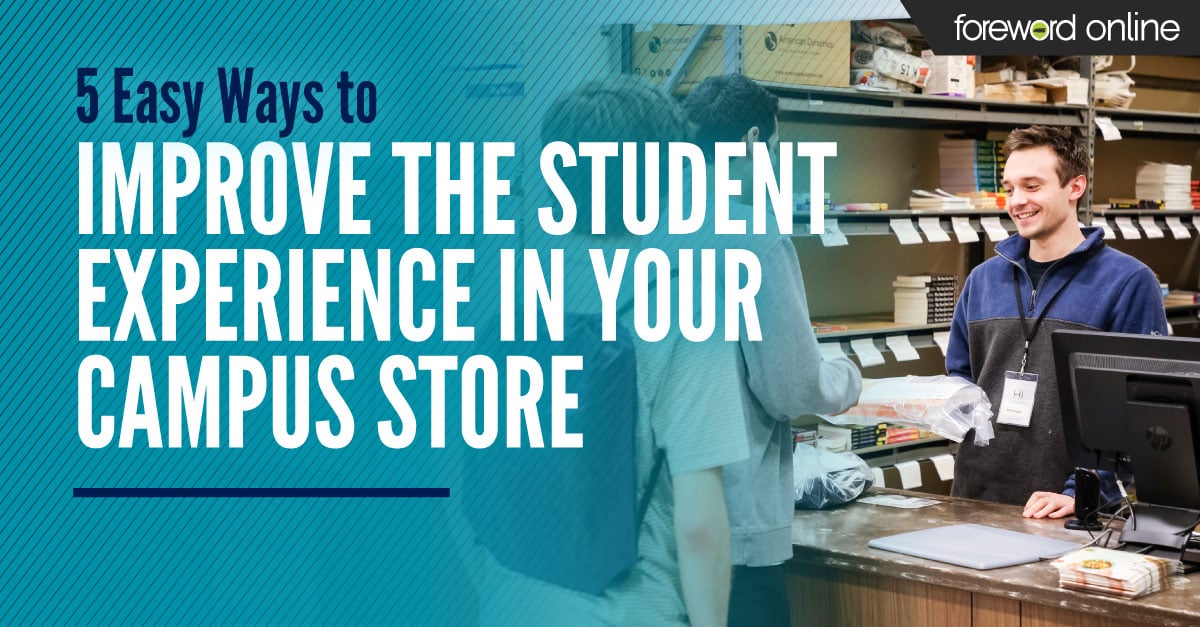In the changing educational landscape, colleges and universities need ways to improve the student experience, increase retention rates and revenue, and meet the student demand for a more affordable college education. The bookstore can play a significant role in supporting your institutional mission and helping students achieve long-term success.

Campus stores are more than just retail. From boosting students’ school spirit to sharing textbook expertise, you contribute to the overall retention and success of the students you serve.
1. Enhancing College Affordability
According to a recent survey, students spent less on course materials in the Spring 2018 term than the Spring 2017 term. While there are many contributing factors (format options, OER, illegal downloading, etc.), fewer students also had their materials by the start of class. Textbooks are a critical part of learning. When students don’t have their books, learning outcomes suffer.
87% of students consider course materials to be overpriced
Generation Z and nontraditional students are fiscally aware and demand an affordable education. As a result, administrative leaders are assessing all areas where students can save, including on their textbooks. By sharing and explaining all the ways your bookstore goes above and beyond to maximize student affordability, you become a knowledgeable, prominent voice in the campus discussion about course material affordability.
Ways your store can further contribute to college affordability initiatives
• Use your course material expertise to guide students and faculty
The course materials industry is complicated. Students and faculty have a plethora of options available, but if they don’t fully understand how each option works, then they may not make the best, most cost-effective choice. You know more about course materials than anyone else on campus. Using that expertise to help students understand how to maximize their course material savings will build trust and ensure students are getting the materials they need.
85% of students say paying for textbooks and course materials is financially stressful
One way bookstores begin sharing the affordability message is by participating in student welcome events. Stores use this opportunity to inform students and parents about the course material options available in the bookstore and introduce the bookstore as course materials experts there to help students.

“Textbooks are a critical component of the entire student experience. We have surveys that tell us that typically less than a third of the students have books for the first day of class, which is unfortunate and can put them behind in their courses — not the best way to begin a semester,” Len Oser, general manager UConn Bookstores, “That’s why it is important for the bookstore to get the message out. We are trying to not only enhance the educational experience but save students money at the same time.”
• Provide students with affordable options
The ever-growing number of course material formats available makes textbook management challenging, especially when issues arise. However, many of these options provide students with an affordable alternative. While your store stays up to date on the latest course material options, students and faculty may not.
One of the latest format options designed to help students save is publisher rentals. While these rental textbooks provide more options to faculty and students, they also increase the need for knowledgeable customer service from the college store. Make sure faculty understand how publisher rentals work and help educate students about the materials available to them to maximize affordability.
73% of students think having access to textbooks is more important than owning them
Some stores have found that simplifying the student rush experience gives students a more favorable impression of the college store. Electronic shelf labels make it easy for students to price compare the available options for their textbooks in your store.

North Dakota State University Bookstore added digital shelf tags and reorganized their textbooks by the author’s last name. These updates have produced impressive results that helped streamline purchasing course materials for students.
“Our customer service desk used to be inundated with people asking when books would come in. Now that we don’t have to do the labor-intensive changing of tags, we save the labor of one full time employee who used to be in charge of changing physical shelf tags every term — which helps our bottom line. This semester that employee had more time to do more outreach with faculty,” Kim Anvinson, store director NDSU Bookstore, said. “The digital tags are fantastic. If the price is wrong, we can get that updated right away. They especially help when we have a book out of stock. We can assist the students right there. Or, if we aren’t with the student, they can see if the books are on order.”
• Keep a clear channel of communication open with faculty
Student affordability starts with faculty. While the bookstore can offer more options (when they are available) to help with affordability, textbook prices hinge on the books that are adopted and the timeliness of the adoptions. Keeping clear channels of communication open with faculty about course materials helps lower the cost of course materials on your campus.
Faculty members have a lot on their plates and changes in the course material industry probably haven’t registered with many of them. For faculty, the valuable hours it takes to find the least expensive options or research course materials innovation could be spent meeting with students or working toward career goals.

“I push back on the notion that every class has to use digital material of any kind. Each class is different, each school is different," Jesse Stommel, executive director of teaching and learning technologies at the University of Mary Washington in Virginia, told the Washington Post. “Every institution should have a goal to educate faculty and students about what is available and be there to support them as they make the choices.”
Helping faculty research and understand how adoptions affect affordability and giving them information on how different formats can save students money will start an ongoing dialogue between the bookstore and faculty members about course material affordability.
The Ichabod Shop at Washburn University in Topeka, Kansas tried using memes to remind faculty members about adoption deadlines, hoping the humorous emails would get more interaction. Not only did it work, but it also strengthened the overall relationship between faculty members and the bookstore.
“It’s been working well,” Nikki Daniels, course materials director at Ichabod Shop, said. “I get a lot of responses from people about the memes, so I know they see it. I have also received questions from faculty about how they can copy their adoptions from one term to the next, so we have a conversation.”
2. Improving Learning Outcomes with Technology
Students don’t just like technology, they expect it. Gen Z students have grown up in a world where everything has always been easily accessible. These students come to college expecting no less from their school experiences.
Digital course materials can provide students with more ways to save, and innovative technology has enhanced digital materials far beyond a simple eTextbook. Adaptive courseware and enhanced OER helps faculty provide students with a personalized learning experience that uses analytics to identify the areas where students need the most help.
81% of students say easily accessible digital course materials would have a positive impact on their grades
Ways your store can improve student learning outcomes with technology

• Simplify student access with digital content
There will probably always be at least some debate when it comes to print or digital. Whether you prefer one to the other, students want the choice. Many students choose digital options for very good reasons. Some may base their decision on affordability, and others want easy access to their materials.
Digital content can provide students with disabilities a better learning experience, they can be integrated into your campus’ LMS, they can be accessed across devices and their interactive functionality can help improve learning.
Adaptive learning materials and OER courseware can also give faculty a way to better analyze student learning in the classroom. These formats provide analytics that allow for real-time teacher to student feedback, which can increase retention and improve graduation rates.
88% of college students believe they would get better grades with interactive content
“We saved our students about $500,000 just this semester alone.”
Kim Anvinson
Store Director
NDSU Bookstore
• Ensure students have materials with inclusive access
Many college bookstores bring inclusive access to their campuses, offering students more convenience and greater affordability. These stores start small, hand selecting courses where inclusive access would make the most sense or help the most students.
By including the cost of books in tuition, inclusive access programs ensure students are prepared for class and save students money. Students are given the choice to opt out (in some cases, opt in) to inclusive access. The guarantee of greater sell-through rates allows for better collective bargaining, which reduces the cost students pay for the same materials. By working directly with schools, departments and faculty, many bookstores have successfully introduced inclusive access programs on their campuses.
North Dakota State University made headlines last year by implementing changes to increase efficiency and save students money. The store’s inclusive access program had 35 participating classes.
“We saved our students about $500,000 just this semester alone,” Kim Anvinson, store director NDSU Bookstore, said. “It’s also the first time in a long time that we have had an increase in unit sales. Inclusive access came because our campus is really pushing affordability as our main focus. Our goal is to make books more affordable to students.”
50% of students say their grades were negatively impacted by their decision to delay or avoid purchases
3. Enhancing the Student Experience
The experience students have in your store contributes to their overall impression of your college. When students experience positive, knowledgeable and helpful service from the bookstore, they feel welcomed into the campus community. This person-to-person attention also gives students another trusted campus resource that they can turn to with questions.
Your bookstore is more than what it sells. An inviting store with easy snack options, comfortable seating and products that encourage students to spend more time demonstrates that they are welcome to spend as much time in the store and on campus as they want.
According to Nielsen research, Gen Z is 59% more likely to connect with brands on social media
Ways your store can improve students’ experience with your campus

• Implement easy in-store textbook pickup
Textbooks are a vital part of student success. It’s simple. Students who don’t have their books, don’t do as well in class. However, digitally native students are not used to the rush shopping experience. Long lines and hard-to-find books can drive students online. By providing students with an uncomplicated way to order and pick up their books in the bookstore, you give them the best of both worlds. Students get the in-person experience they like, while bypassing long lines.
Accounting for their students' shopping preferences, the CU Book Store streamlined their textbook pickup process for orders, which had a big impact on the shopping experience.
“They go to a terminal, type in their log-in credentials and receive self-pick-up instructions for their box of books shelved in a convenient numerical fashion on special shelving. As they leave the area the instructions and box are scanned to validate the pick-up and they’re done, leaving with a great store experience that makes them want to come back later during the first week of classes to buy supplies and other items,” Chris Gotski, director of CU Book Store, “We have also improved our checkout process in the store with more registers and better line control, making the waiting time for students who don’t order their books ahead of time only about five to seven minutes.”
58% of Gen Z want pick up or delivery options
• Provide an omnichannel experience
The term omnichannel is used a lot, but what does it really mean? Providing customers with an omnichannel experience is more than a checklist of places where your bookstore should be: a physical store, a website, an app, social media, etc. To give customers the experience they expect, they should be able to go from one location to the next and maintain a seamless experience.
Having a truly integrated experience means that shopping online with your store is no different than coming into the store. Customers can view and research the products they want to buy on your website and then go into your store and see the same selection in person. Or, if the student decides to make an online purchase, they can easily and quickly pick it up in your store or return the items that don’t work for them.

Give students a gaming experience
Gaming isn’t just a hobby for many Gen Z students, it is part of their identity. Catch tech savvy students’ attention by giving them an experience they can’t get at home. The Aztec Shops’ Campus Stores at San Diego State University understands the appeal of video games to their students. Investing in gaming chairs, a PlayStation and 75-inch TV for their store, the Aztec Shop invites students and visitors to book time in the reactive seats where they can watch YouTube videos or play a game.
“We just wanted to get the students in the store — not because we wanted them to buy something, but so they have somewhere to go,” Kathy Brown, division director Aztec Shops’ Campus Stores, said. “So, if they do in the future need something, they can trust us and come to us and know that we’re here to support them.”
66% of Gen Z list gaming as their main source of entertainment
• Plan a regular schedule of events
Every store may not have the room or budget to create gaming or seating areas within their walls, but all stores can host student events throughout the year to bring students into the store and build a stronger connection with students. Bookstore events make your store more than just a place to get course materials. They help change students’ view of the bookstore’s role on campus.
Large sales, flash sales, charity collections, community events, scavenger hunts, costume parties … the options are almost endless. Taking the time to brainstorm with your regular and student staff about the events that would have the biggest impact can result in a big payoff. Also, don’t forget to check out your school’s campus calendar and join in with celebrating exciting campus events.
Check out our 2018 Think, Plan, Do marketing plan for a year of event ideas with promotional materials

• Harness school spirit to do more for your campus community
Use school events to raise student awareness about campus programs like food banks or other resources available to students in need. The University of Tennessee’s Volshop uses Big Orange Fridays to support Smokey’s Pantry, a service that offers free food to students in need.
“We decided our stores would do a food and health and beauty aid collection every Friday in conjunction with Big Orange Fridays,” Carol Miller Schaefer, director of the University of Tennessee’s Volshop, said. “Every couple weeks, we deliver the boxes we collected to Smokey’s Pantry, and they are very grateful to get that. I think that it has provided a good opportunity for awareness that there are students who don’t have food. It’s one of those things where you don’t even realize that there’s a problem. Our student employees have even said that’s a really good idea. They know people who are living in that situation. The collection helps tie together the reality many students face to what we do here in the store.”
According to Barnes & Noble College Gen Z research, 56% of the Gen Z students surveyed have tried to participate in or effect social change by actively engaging with issues that matter to them
• Expand what your store offers
Snacks are a great way to bring in students of all ages and backgrounds. Busy students racing between classes and their jobs might not have time to pick up lunch or dinner. Having quick, easy and healthy snack options can give students the energy boost they need to make it through their day.
In addition to snack options, look at the students on your campus and what they like right now. While you can get ideas about your students from more general data and research, your students are unique. Many factors go into what students want to see and purchase from their campus store. Paying attention to the habits and local interests will help you carry the products students want.
Lane Community College’s Titan Store watches sales data and numbers to think strategically about the merchandise trends critical to staying current with students. Knowing that most of their students are in-state, they stock items that appeal to Oregonians: outdoor gear and merchandise made from recyclable, renewable materials.
“Everybody in Oregon walks around with a water bottle of some kind. We brought [Hydro Flask] in and it’s a higher end product, but because it’s actually a popular product in Oregon, people buy it,” Titan Store Director of Retail Services Tony Sanjume said. “It’s one of those things. You can’t sell cheap sweatshirts sometimes, but you can sell Nike® or Under Armour®, because people identify with the brand.”
College stores have a unique connection with students. You are more than retail and have a direct impact on student success and retention.





